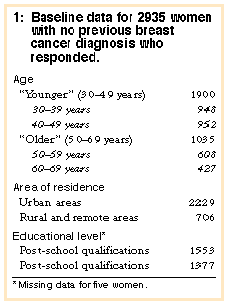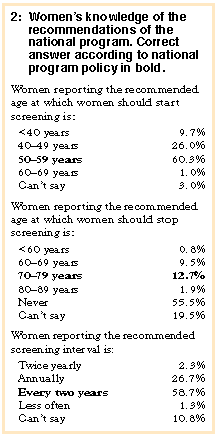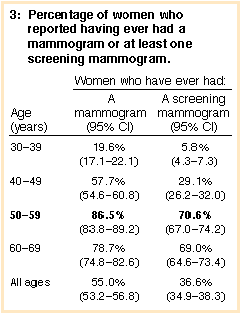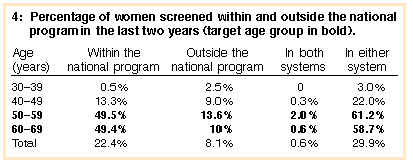Mammographic screening: results from the 1996 National Breast Health Survey
Alexandra L Barratt, Jill Cockburn, Sally Redman, Christine Paul and Janice Perkins
For editorial comment, see Glasziou & Irwig
This article has been cited in Rodger A, Kavanagh AM, Outcome measures of an Australian breast-screening program, MJA 1998; 169: 179-180
Readers may print a single copy for personal use. No further reproduction or distribution of the articles should proceed without the permission of the publisher. For permission, contact the Australasian Medical Publishing Company
Journalists are welcome to write news stories based on what they read here, but should acknowledge their source as "an article published on the Internet by The Medical Journal of Australia <http://www.mja.com.au>".
Abstract - Introduction - Methods - Results - Discussion - References - Authors' details
- - - ©MJA1997
Abstract |
Objective: To establish the extent of women's
knowledge of mammographic screening, particularly in relation to
the national screening program, BreastScreen Australia, and to
estimate the proportion of women who are participating in screening
both within and outside BreastScreen Australia. Design and setting: Validated prospective telephone survey of women aged 30-69 years selected at random from across Australia. Participants: 2935 women with no previous breast cancer diagnosis. Results: The adjusted response rate was 64%. Almost 90% of women had heard of the national program; only 1% correctly stated that screening is for asymptomatic women. 60% correctly identified the current recommended age of starting screening is about 50 years of age; 26% thought screening should begin at about 40 years of age. Approximately 60% correctly reported that the recommended screening interval is every two years; 27% thought screening should be done annually. 55% reported ever having had a mammogram, and 37% reported having had at least one screening mammogram. Among women in the target age group (50-69 years) about 70% reported ever having had a screening mammogram, and about 50% reported having had a screening mammogram within the national program in the last two years. Among women aged 40-49 years, 29% reported ever having had a screening mammogram, and 22% reported having been screened in the last two years. Conclusions: Awareness of the national screening program is high, but some women do not know the purpose of screening, the target age group and the recommended screening interval. Compliance with screening is good among women in the target age group; many women in their 40s are also participating in screening. |
Introduction |
Breast cancer is the most common cause of cancer death in Australian
women, with approximately 7000 new cases and over 2500 deaths
annually.1 Evidence from
randomised controlled trials shows that mammographic screening can
substantially reduce mortality from breast cancer among women aged
50-69 years,2,3 but high
rates of compliance with screening are necessary to achieve these
benefits.
Since 1991 the Commonwealth and State governments have funded a national program of mammographic screening, BreastScreen Australia, which provides free mammographic screening for women aged 40-79 years, but specifically targets women aged 50-69 years. Clearly, if women are to participate, they need to know about mammographic screening generally, and about the service provided by the national program in particular. In 1996, we undertook a national survey on behalf of the National Health and Medical Research Council National Breast Cancer Centre (NBCC) to establish baseline information about women's knowledge of, and participation in, screening mammography. Limited data about participation within the national program are available from the national program's own evaluation reports. Little is known about participation in screening outside the national program. Our aims were, firstly, to determine Australian women's knowledge of mammographic screening and the national program, and whether knowledge differs by area of residence or education. Secondly, we aimed to estimate the proportion of women who are participating in screening both within and outside BreastScreen Australia. |
Methods |
The survey was conducted by telephone by a market research company on
behalf of the NBCC in April 1996. The questionnaire was developed and
pilot-tested by the NBCC; test-retest reliability was assessed by
administering the questionnaire twice to a random sample of 100 women
at a one-week interval, with good agreement for key items ( k =
0.89-1.00).
Telephone numbers were chosen at random from the electronic white pages telephone directory. Up to five callbacks were made to contact eligible women (those aged 30-69 years whose English was sufficient to complete a telephone interview). The sampling frame was stratified to ensure participation by women in all States and Territories, and in urban and rural areas.4 The outcome of every phone call was recorded. Ethical approval for this study was obtained from the NSW Cancer Council Ethics Committee in March 1996. |
Validation |
A random sample of 150 women who reported having been screened by
BreastScreen Australia were asked for consent to check their
questionnaire answers against BreastScreen Australia records. For
those who consented, identifying data and the estimated date of last
screen within the program were forwarded to BreastScreen Australia
for confirmation.
To assess selection bias, one survey question (Have you ever had a mammogram?) was placed in the February 1996 Australian Bureau of Statistics (ABS) Population Survey Monitor, which is conducted quarterly by household interview. The question was asked only of women 30-69 years in the ABS sample, and the results were weighted as for our survey (described below) to give a comparable estimate. |
Statistical analysis | Our data were weighted for area of residence and age based on ABS projected population estimates. As all percentages reported in this paper are weighted results, sample sizes are not routinely given in the results. Significance testing was done by chi-squared tests based on the sample size of the survey; P values of less than 0.05 were considered statistically significant. Ninety-five per cent confidence intervals were calculated from the standard error of the proportion, again based on the sample size of the survey. Education was coded according to ABS categories and collapsed to those with post-school qualifications and those without post-school qualifications.5 Age was classified as younger (30-49 years) and older (50-69 years) to differentiate women within and outside the target age range of the national program. |
Results |
The raw response rate was 70.2% (calculated as completed interviews
[3014] over contacted eligible women [4291]). After inflating the
denominator by the estimated number of eligible women among those who
could not be contacted (n = 389), the response rate was 64.4%.
Seventy-nine women who had previously been diagnosed with breast
cancer were excluded. The demographic characteristics of the
remaining women are shown in Box 1.
Of the 150 women asked, 127 (85%) consented to having their screening records checked. Of 126 women who reported having been screened within BreastScreen Australia within the last two years, attendance was confirmed for 121 (96%). Twenty-six per cent of women were able to recall the mammogram date accurately to the day, and a further 38% accurately recalled the month. Ninety-two per cent of women reported the mammogram date accurately to within 12 months. The weighted ABS estimate for the question Have you ever had a mammogram? was 50% (95% CI, 46.9-53.2). |
Responses to specific questions |
Do you know any ways to detect breast cancer in the early stages?
-- 63.2% of respondents nominated mammography without
prompting. Those more likely to nominate mammography were older
women (chi-squared = 14.99; P
< 0.01) and women with post-school qualifications (chi-squared = 12.05; P< 0.01).
The Commonwealth and State governments fund a mammographic screening program in Australia known as the National Program for the Early Detection of Breast Cancer. In [respondent's State] it is known as [program name in respondent's State] . Have you heard of this Program? -- 88.7% of women responded that they had heard of the national program. More women in rural areas than in urban areas had heard of the program (92.9% v. 87.0%; chi-squared = 14.82; P< 0.001). More older than younger women had heard of the program (93.1% v. 86.2%; chi-squared = 42.09; P< 0.001). There was no difference in the proportion who had heard of the program by educational level. Which women do you think should attend for mammographic screening; only women who have no symptoms of breast cancer ; only women who have symptoms of breast cancer ; or it doesn't matter whether women have symptoms or not? -- only 1.3% of women correctly replied that screening was for women without symptoms, 2.9% replied that it was for women with symptoms, and 94.8% replied that it didn't matter. Slightly more younger women than older women thought screening was for women with symptoms (3.6% v. 2.0%; chi-squared = 11.70; P< 0.009). There were no differences between women living in urban and rural areas or according to educational level. When does the government program recommend women should start (stop) having mammograms? -- 60.3% of women correctly reported that the recommended commencement age was 50-59 years; 26.0% reported it was 40-49 years (see Box 2). More younger women than older women reported that the recommended commencement age was 40-49 years (28.1% v. 22.5%; chi-squared = 58.73; P= 0.001). Again, there were no differences in these proportions between women living in urban and rural areas or according to educational level. Most women (55.5%) thought screening should never cease, and 19.5% of women were unable to say when screening should stop (Box 2).
How often does the government screening program suggest women should have a screening mammogram? -- 58.7% correctly reported that the government program suggests screening should be done every two years, but 26.7% reported that annual screening is recommended. More younger women than older women reported that annual screening is recommended (32.1% v. 17.4%; chi-squared = 178.76; P< 0.001). |
Referral and access to the government program |
Of respondents in the target age group (50-69 years), 34.7% reported
that their GP had suggested they have a mammogram as part of the
government program. This proportion did not vary by area of residence
or by education level. Among all respondents, almost all women
(95.8%) reported having visited a GP within the last two years.
Among women in the target age group, 84.0% knew that a screening mammogram within the national program was free. More women with post-school qualifications knew this (87.9% v. 80.9%; chi-squared = 9.30; P= 0.01), but the proportions did not vary according to area of residence. Most women in the target age group (65.8%) reported being very confident of knowing how to make an appointment for a mammogram within the program, and this proportion did not differ according to area of residence or educational level. |
Participation in screening mammography |
A series of questions was used to determine whether women had had a
mammogram within or outside the national program. To determine
whether it had been a screening mammogram, they were then asked,
When you had [that mammogram] was it because you already
thought you had some problems with your breasts?. Overall, 55.0%
of all women reported ever having had a mammogram (Box 3). The
frequency of having had a mammogram rose steeply with age, peaking in
the 50-59 years age group at 86.5%. Overall, 36.6% of women reported
having had at least one screening mammogram (Box 3). Among women aged
30-39 years, approximately 6% reported having been screened, and
this proportion rose to approximately 70% in the 50-69 years target
age group. Having had a screening mammogram was not associated with
area of residence or with education.
In the target age group (50-69 years), 49.5% of women reported being screened in the national program within the last two years, and this was not influenced by area of residence or educational level. Another 12.1% reported having been screened outside the national program within the last two years. Among women 30-39 years of age, only 3% had been screened in the last two years, mostly outside the national program. In the older age groups, most women reported being screened within the national program (Box 4). |
Discussion |
Our findings are the first validated, baseline estimates of
Australian women's knowledge of, and participation in,
mammographic screening since the establishment of the national
program.
Our adjusted response rate of 64% compares well with those of similar reported surveys.6-8 The estimate by the ABS for the identical question Have you ever had a mammogram? was 50% (95% CI, 46.9-53.2) compared with ours of 55% (95% CI, 53.2-56.8), suggesting that our estimates are likely to be only minimally affected by selection bias. However, we excluded some women, notably non-English speakers and those living in homes without telephones. Also, as it is likely that women who chose to participate were more aware of breast cancer and screening mammography than those who refused, our data may overestimate both women's knowledge of, and participation in, such screening. Awareness of the national program was high (nearly 90%). Although asking a prompted question may have inflated this estimate, the result does suggest that the promotion of the program has been effective. The vast majority of women knew that the national program is free, and that it recommends women start screening at around 50 years of age and have a screening mammogram every two years. Most women also felt very confident in knowing how to access the program. The absence of significant variation in knowledge about screening mammography according to area of residence or educational level suggests that the national program has been successful in widely promoting screening. However, consistent with a previous study,9 most women were not aware that screening is intended only for asymptomatic women. Most women thought symptoms didn't matter, suggesting they appreciate to some extent that the national program is not designed for the evaluation of symptoms. While this may be encouraging, it is still of some concern as people who do not appreciate the distinction between diagnostic and screening tests may be more likely to seek compensation for missed diagnoses.9 As most women reported that their GPs had never recommended they attend the national program for screening, there is a greater opportunity for GPs to recruit more women to screening. Our findings indicate that attendance for mammography is becoming increasingly common. Surveys conducted in 1988 found that only 18% of women spontaneously mentioned mammography as a means of detecting breast cancer in the early stages, and 50% claimed to have heard of it when prompted.10 Only about 10%-20% of women had ever had a mammogram, about half for diagnostic and half for screening purposes.7,11 Clearly, this situation has changed dramatically, with 60% of women now nominating mammography as a means of early detection in an unprompted question, 55% of all women reporting having ever had a mammogram, and 37% of women reporting having had at least one screening mammogram. High proportions of women in the age group targeted by the national program reported having been screened at least once (70%) and having been screened in the last two years (about 60%). Many more of these women are being screened as part of the national program than outside it. Our finding that 49.8% of women in the target age group had been screened within the national program in the last two years is consistent with BreastScreen Victoria's estimated participation rate of 47.7%.12 Recent meta-analyses showing a small reduction in mortality after about 10 years of screening for women aged 40-49 years13 have prompted heated debate over whether younger women should also be targeted for screening. It is interesting to note that we found quite high screening rates among women aged 40-49 years, indicating that many women in this age group are, in fact, already being screened. |
References |
(Received 11 Mar, accepted 12 Aug, 1997) |
Authors' details
Department of Public Health and Community Medicine, University of Sydney, NSW.Alexandra L Barratt, PhD, FAFPHM, Lecturer.
Discipline of Behavioural Science in Relation to Medicine, University of Newcastle, NSW.
Jill Cockburn, PhD, Head.
National Health and Medical Research Council National Breast Cancer Centre, Sydney, NSW.
Sally Redman, PhD, Director; Christine Paul, PhD, Consultant Behavioural Scientist.
New South Wales Cancer Council Cancer Education Research Program, Wallsend, NSW.
Janice Perkins, PhD, Research Associate. Currently at the Discipline of Behavioural Science in Relation to Medicine, University of Newcastle, NSW.
No reprints will be available. Correspondence: Dr A L Barratt, Department of Public Health and Community Medicine, Building A27, University of Sydney, NSW 2006.
- ©MJA 1997
<URL: http://www.mja.com.au/>
© 1997 Medical Journal of Australia.
Received 20 December 2025, accepted 20 December 2025








